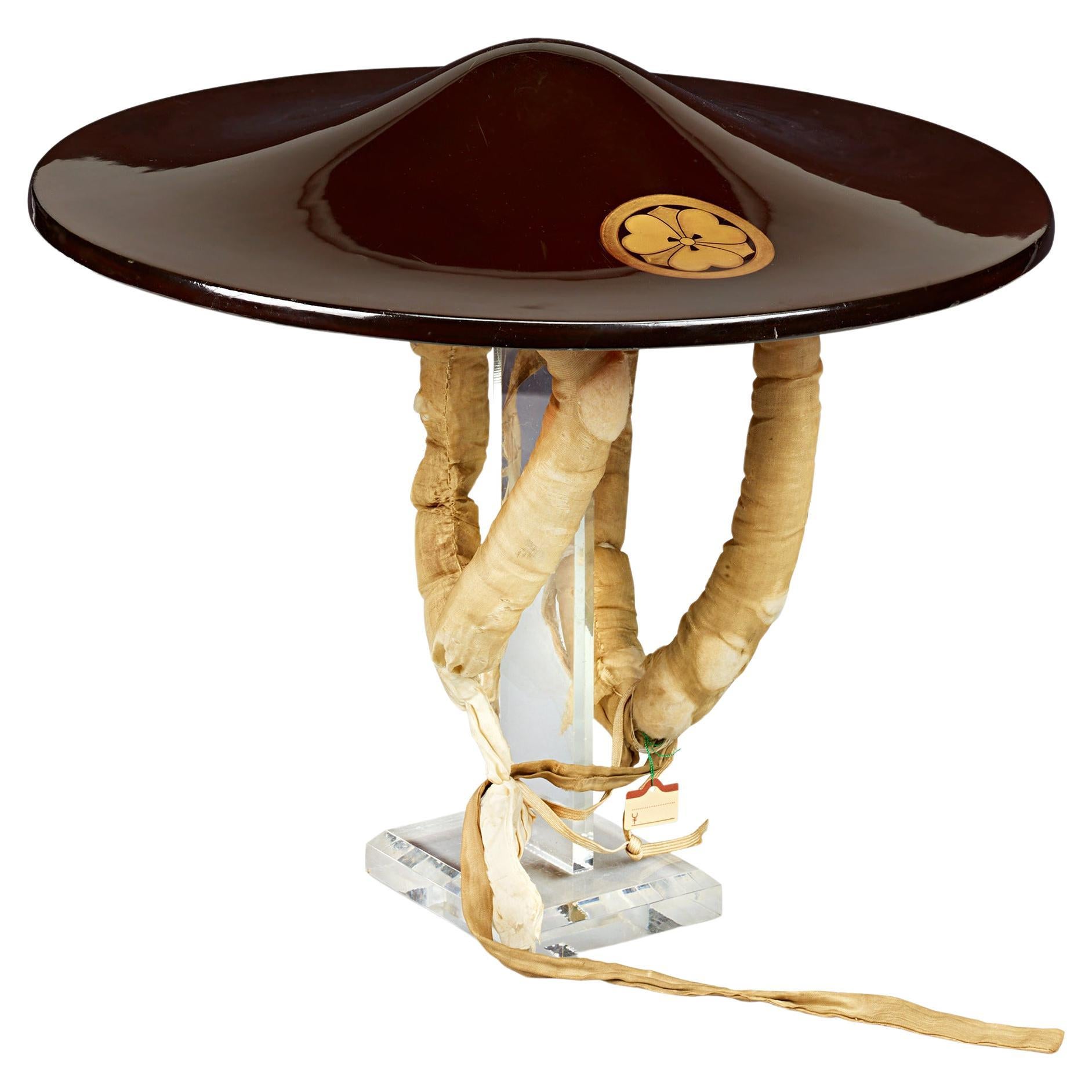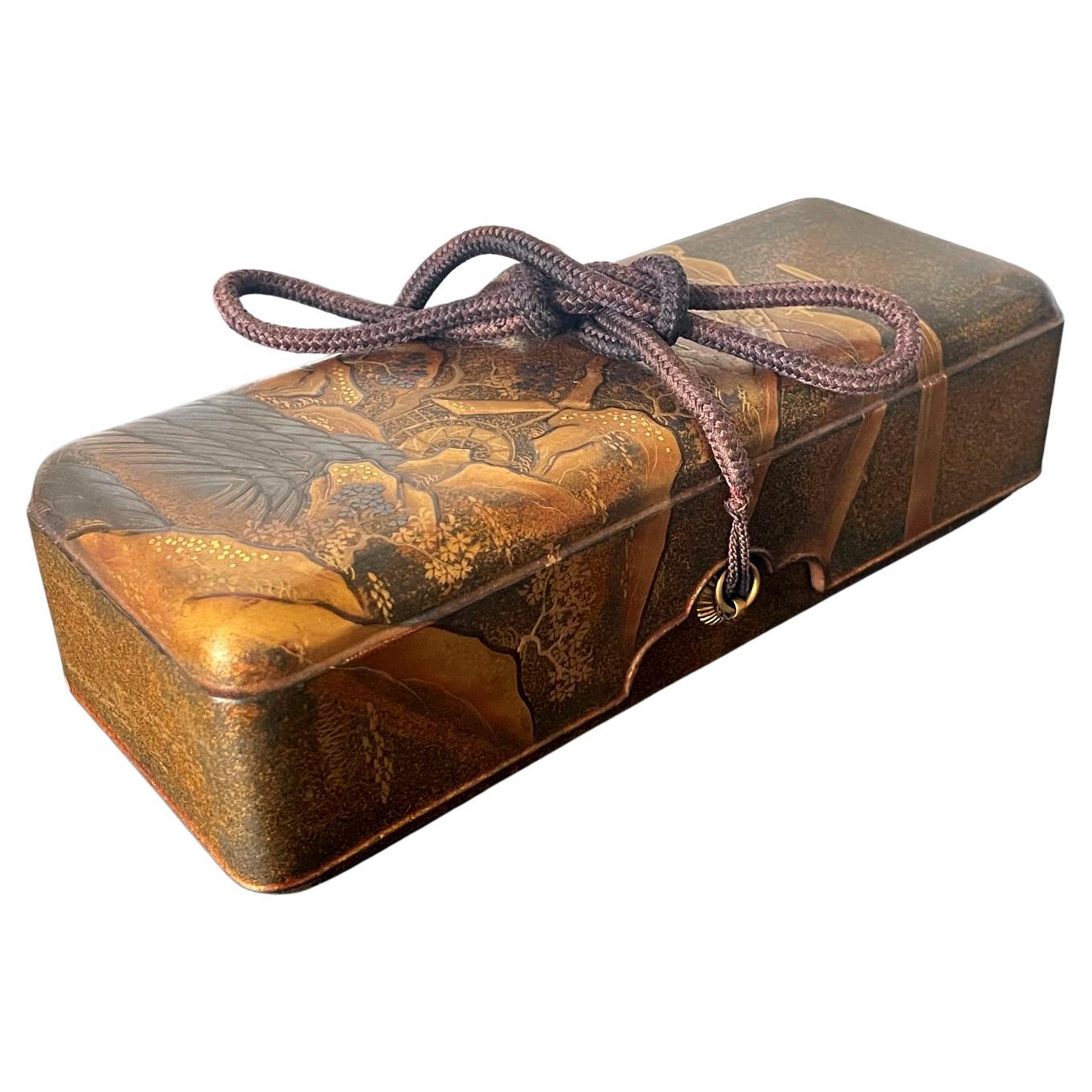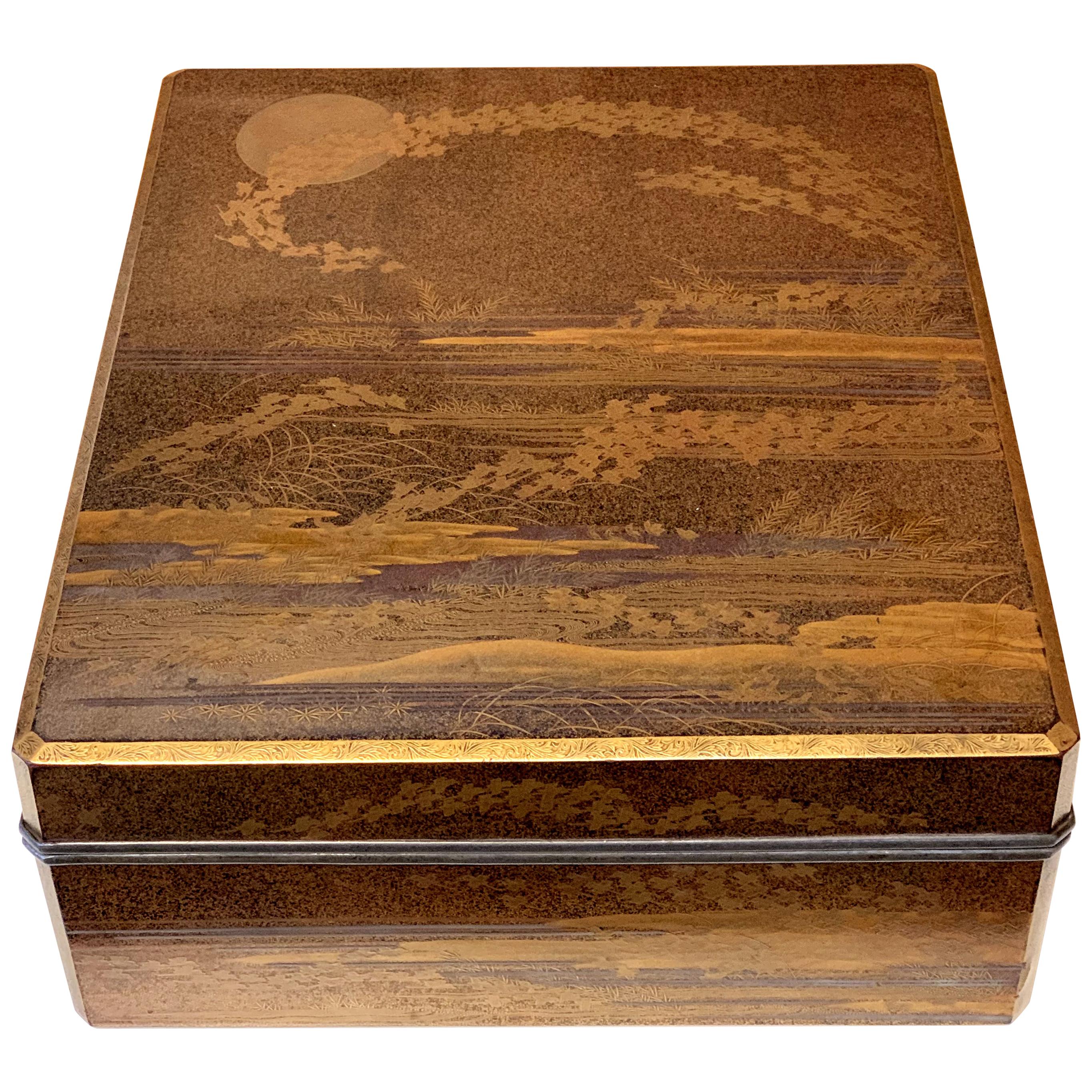Items Similar to Japanese Lacquered Samurai Jingasa Hat Edo Period
Want more images or videos?
Request additional images or videos from the seller
1 of 17
Japanese Lacquered Samurai Jingasa Hat Edo Period
About the Item
A bespoken Japanese historical hat known as Jinggasa (militant hat) that was worn by samurai in Edo period (1603-1868) circa 18-19th century. There were several subtypes of Jingasa and this is a type called ichimonji gasa or hara gasa (flat type). It was were constructed from layers of paper and cloth with heavy surface lacquer with brass hardware accoutrement and tassels. It was made strong enough to be worn as a helmet and often waterproof. On Jingasa worn by higher ranks of samurai members, there was always a mon (family crest) in gilt lacquer on the surface as an identification.
This Jingasa stands out in its rather unusual decorations. The black exterior features a highly textured surface that resembles tree bark. The underside, which in most cases covered with a simple layer of monochrome lacquer, was lavishly decorated in gold leaf stripes and powder splashes on a bright red background. The overall visual effect is therefore very striking. The exterior surface also showcase a fifteen-leaf Sasa (bamboo) Mon toward the front, three tridents radiating from the metal tehen kanamono (the kiku shape hardware that covers the top center knot), and on the back, a ring (called kasa jirushi no kan) for the decorative agemaki bow. Underneath the hat, there are four rings where the red cord is fastened to be used to tie under the wearer's chin.
The Jingasa appears original with mellow patina and wears along the edges and on the surface that are consistent with its historical use.
- Dimensions:Height: 4 in (10.16 cm)Diameter: 16.5 in (41.91 cm)
- Style:Japonisme (Of the Period)
- Materials and Techniques:
- Place of Origin:
- Period:
- Date of Manufacture:18th-19th Century
- Condition:Wear consistent with age and use. Minor losses. Small historical losses (dumps and nicks), mostly along the rim, a couple on the black and red surface as well. Hardware appears original. Red cord/tassels in good shape, not sure if it is original. Present beautifully as it is with the patina.
- Seller Location:Atlanta, GA
- Reference Number:1stDibs: LU945023942912
About the Seller
5.0
Platinum Seller
These expertly vetted sellers are 1stDibs' most experienced sellers and are rated highest by our customers.
Established in 2006
1stDibs seller since 2010
477 sales on 1stDibs
Typical response time: <1 hour
- ShippingRetrieving quote...Ships From: Atlanta, GA
- Return PolicyA return for this item may be initiated within 2 days of delivery.
More From This SellerView All
- Japanese Lacquered Maki-e Fubako Edo PeriodLocated in Atlanta, GAA Japanese lacquered wood fubako (a box used to store document or small scroll painting), circa second half of 19th century late Edo period. The rectangular box features an unusually deep lipped lid with slightly rounded corners, a conforming lower box that is almost entirely covered by the lid which has two bronze medallion rings with tasseled...Category
Antique 19th Century Japanese Edo Lacquer
MaterialsWood, Lacquer
- Large Japanese Lacquer Box Early Edo Period Ex-Christie'sLocated in Atlanta, GAA large lacquer Ryoshibako (Paper box in Japanese) finely decorated with Maki-e circa 17th century early Edo period. The box is of an impressive size and was used to store paper documents. Both sides of the lid were elaborately decorated with maki-e and the edge was befitted with lead rim, an early practice before the silver rim became common later. The interior and base were finished in Nashiji. The night scene on top surface of the lid depicts flocks of chidoris flying in formation from a sea shore swaying with reeds under a full moon, using hiramaki-e in both gold and silver. Ribbons of clouds were achieved with different densities of gold powder. The underside, in contrast, shows a crescent moon in takamakie-e above the sea with ferns and reeds. Chidoris, the plovers, are symbolic in Japanese culture as "thousands of blessings" and longevity. The Namichidori, the pattern in which the chidori flies in the nami (wave) represents the eternal love and safety of couples and families. For detailed references on the historical background and the use of chidoris on lacquerware, see the reference below. This very lacquer box was featured for sale as lot 339 in Christie's London Sale Japanese Art...Category
Antique 17th Century Japanese Japonisme Lacquer
MaterialsWood, Lacquer
- Rare Japanese Sumi-E Lacquer Inro Yamada Jokasai Edo PeriodLocated in Atlanta, GAA three-case lacquered Inro by Yamada Family circa 18th-19th century Edo period. The inro with slight rounded form is of Kano style and vividly depicts a dragon slithering among the ink clouds on a gold background. Sumi-e togidashi (ink togidashi) technique, in combination with Hiramaki-e, were employed to create the dreamy ambience of this piece. The dragon has a painterly appearance inspired by Chinese ink painting that was often seen on the Japanese folding screens. The back of the Inro was sparsely decorated with the shifting patterns of the darkening clouds with an emphasis on the space intentionally left empty. Jokasai was signed to the base. On the front of the inro there is another miniature signature Hakugyoku Hogen, which is one of names used by Kano Michinobu (1730-1790). The dragon is evidently one of his designs (see reference below). Established by a member of Yamada family in the 17th century, the clan was one of the most prominent lacquer artisanal family for the next 200 years until the end of Edo period in the 19th century. Most members signed their work simply with Jokasai making the identification of the individual artists somewhat impossible. The current Inro on offer, compared to many other pieces by Jokasai, has an uncommon Kano style done in Sumi-e togidashi. Another unusual feature of this piece is that the interiors of the inro was decorated with an interesting gold mosaic inlays (kirigane) on a dark lacquer background, giving it a jewel like quality. For another Inro by Jokasai of a similar style using Sumi-e togidashi but depicts a tiger, see Wrangham collection, no.353, which was offered for sale as lot 256 in Bonham's London Auction: The Edward Wrangham Collection of Japanese Art Part I. 9 Nov 2010. For an ink scroll...Category
Antique 18th Century Japanese Japonisme Lacquer
MaterialsWood, Lacquer
- Japanese Antique Ewer Lacquer with Bronze Edo to Meiji PeriodLocated in Atlanta, GAA Japanese lacquer water ewer without handle (known as hazo in Japanese) that was used to carry water, traditionally together with a large basin (known as tsunodarai) for domestic us...Category
Antique 19th Century Japanese Japonisme Lacquer
MaterialsBronze
- Exquisite Japanese Lacquer Maki-e Suzuribako by Koma Kyūhaku Edo PeriodLocated in Atlanta, GAOne of the finest Japanese Maki-e Suzuribakos (ink box) we have on offer, the roiro color box showcases an ambient nocturnal scene in which two shakudo inlaid crows perched on the handrails of a bridge (possible the Uji Bridge...Category
Antique Early 19th Century Japanese Japonisme Lacquer
MaterialsStone, Metal
- Japanese Lacquer Tray with Maki-e and Inlay Hara Yoyusai Edo PeriodLocated in Atlanta, GAA lovely Japanese lacquer rectangular lacquer tray with a slightly scalloped corner and four L shape supporting feet by one of the most celebrated lacquer artist active in Edo period Hara Yoyusai (1772-1845). Yoyusai lived in Edo (Tokyo) and worked under the patronage of Lord Matsudaira. He operated a large workshop and had a very prolific output of lacquer objects. Most survived pieces being inro...Category
Antique 19th Century Japanese Japonisme Lacquer
MaterialsWood, Lacquer
You May Also Like
- Edo-Period Lacquered JingasaLocated in New Orleans, LAComplete with a lacquered surface and original silk straps, this Japanese Edo-period traveling hat, or jingasa, first emerged during the illustrious period between 1603 and 1868, a t...Category
Antique 19th Century Asian Edo Lacquer
MaterialsSilk
- Japanese Lacquer and Cinnabar "Samurai" Cabinet, Inaba Family, Edo PeriodLocated in Troy, NYExceptionally large and rare lacquer cabinet. According to the heraldry, visible on the headgear in one of the panels, it was made for the Inaba family, a high ranking Daimyo family,...Category
Antique Late 19th Century Japanese Edo Lacquer
MaterialsWood
- Japanese Showa Period Dry Lacquer Sculpture of a DuckLocated in Hudson, NYShowa Period (1926 - 1989) sculpture of a duck resting with its head tucked into its wings. Dry lacquer, or kanshitsu, is a process of layering and manipulating lacquer soaked cloth ...Category
Early 20th Century Japanese Showa Lacquer
MaterialsLacquer
- Japanese Samurai Abumi Stirrups Lacquer Edo, 18th CenturyLocated in Dallas, TXJapanese Samurai Abumi Stirrups lacquer Edo late 18th century, early 19th century. Measures: 12 inch length, 10 inch height, 5.5 inch width. AVANTIQUES is dedicated to providing an...Category
Antique Late 18th Century Japanese Edo Lacquer
MaterialsIron
- Small Lacquered Japanese Kazaridana Cabinet, Edo PeriodLocated in Saverne, Grand EstPrecious and rare small kazaridana lacquered on all sides with two drawers and three panels decorated with fish, landscapes and birds. The removable panel reveals a locker with a sma...Category
Antique Late 19th Century Japanese Meiji Lacquer
MaterialsWood
- Pair of Edo Period Black and Gold Lacquer Samurai Helmet BoxesLocated in Lymington, HampshireA pair of Edo period black and gold lacquer Samurai helmet boxes (Hakko Bako), each of ribbed cylindrical form with a lid, a black lacquer interior,...Category
Antique 19th Century Japanese Edo Lacquer
MaterialsLacquer
Recently Viewed
View AllMore Ways To Browse
Brown Lacquer
Lacquered Brass
Lacquer On Wood
Black Lacquer Brass Furniture
Black Lacquer Brass
Black Lacquer And Brass
Black Lacquered And Brass
Red Lacquer Furniture
Lacquer Red
Patina Lacquer Furniture
Black Gold Lacquer
Gold And Black Lacquer
Red Black Lacquer
Black And Red Lacquer
Simple Japanese
Black Lacquered Metal And Brass
Black Lacquer Decorative
Gilt Lacquer Wood





